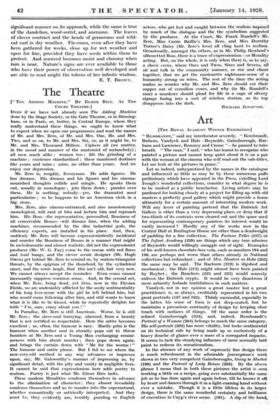Art
[THE ROYAL ACADEMY WINTER EXHIBITION]
" REMBRANDT," said my interlocutor severely, " Rembrandt; Rubens, Vandyck and Hals—Reynolds, Gitinsborough, Rae- burn and Lawrence, Romney and Croine "–The paused to take breath. "The map," I said, "who has learnt to recognize who painted a picture and cannot keep quiet about it is on a par with the woman at the cinema who will read out the-sub-tiries.
Let me look at the pictures in peace." -
Let us indeed, unhypnotized by the names in the catalogue and influenced as little as may be. by those numerous puffs preliminary which, hive appeared in the Press, extolling Lord Iveagh's wonderful collections:- Consider hi what degree he is to be ranked as a benefactor. Living artists may be pardoned for looking closely at a project for filling up withofd masters a perfectly good gallery which might provide a home ultimately for a certain amount of interesting Modern work, Will any lover of painting pretend that the Dulwich Art Gallery is other than a Very depressing place, or deny that if two-thirds of its contents were cleared out and the space used for representingcontemporary painters its interest would be vastly increased ? Hardly. any of the works now in the
Central Hall at Burlington House are other than a deadweight - ,
of padding for a fine collection. The Fortune Teller (237) or The Infant Academy (239) are things which any true admirer of Reynolds would 'willingly smuggle out of sight. Examples of his well-known chocolate-box vein, such as numbers 194 and 196,. are perhaps not worse than others already. in Nationai collections but redundant; and of Mrs. Musters as Bebe (205) the same may be said. - The Raeburn (219) is -Slifishod and mechanical.; the Hals (212) might almost have been painted by Roybet -; the Boucher§. ,(223 and .225) vionld scarcely. enliven the Dulwich crypts. It *Mild be very disastrous if mere urbanity forbade truthfulness in such matters.
Vandyck, not in my opinion a great master but a great practitioner, is, as always, creditably represented in his two great portraits (187 and 192). Thinly successful, especially in the latter, his sense of form is' not deep-seated, but he maintains a precarious continuity of design by keeping close touch with surfaces Of things. Of the same order is the refined Gainsborough (224), and, indeed, Rembrandt's Portrait of a Woman (204) belongs to much the same category. His self=portrait (202) has more vitality, but looks sentimental on its 'technical side by being made up so exclusively of a heavy douche of-glazes over a mass of a corrugated impasto. It seems to lack the steadying influence of more normally laid-
paint to redeem its sensationalism. .
. In the absence of any work of supremely fine design there is- much refreshment in the admirable journeyman'.8 shown in two very competent Gainsboroughs, Going to Market (1po) and the Portrait 'of Lady Brisco (203). By the abrive. IL:arise I mean that in both these pictures the artist is seen working a little on a recipe, going over substantially the same job as he has, done again and again. before, till he knows it off by heart and dances through it in a light-running hand without ever a mistake. Though it is a little lifeless in its larger design, there is the same wonderful certainty and brilliance of execution in Cuyp's river scene. (191). A slip of the hand, would ruin it, but there is no slip. I confeski find it delightful to see anything so well done and -suspect that those of my critical confreres who would shrug 'their shoulders-at "'mere execution" can never have realized by experiment how difficult it is.
Of the recently deceased Academicians Whose work is shown, Cayley Robinson is the most important ; McEvoy, the most successful. If a few of his best portraits only had been shown along with some water-colours, the latter would have held his own well enough against the eighteenth-century masters—as here shown.
WALTER BAYES.



































 Previous page
Previous page